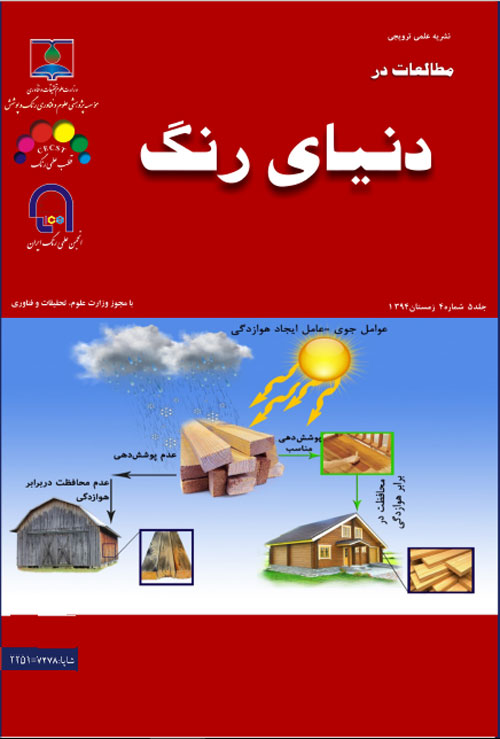فهرست مطالب

نشریه مطالعات در دنیای رنگ
سال پنجم شماره 4 (پیاپی 19، زمستان 1394)
- تاریخ انتشار: 1394/12/22
- تعداد عناوین: 8
-
-
Pages 3-14Photoelectrodes are one of the major components of the dye sensitized solar cells that their role is electrons transport. The nanostructured photoelectrodes can be classified into: 1) nanoparticles with high surface area, 2) 1D nanostructures such as nanotubes and nanowires, 3) 3D photoelectrodes that combine large and small nano particles, 4) 3D photoelectrode and 5) hybrid TiO2/graphene nanostructures. Two important properties of photoelectrodesare high surface area and maximum loading dyes that have direct effect on performance of dye-sensitized solar cells. This review briefly discuses phoelectrodes for dye-sensitized solar cell.Keywords: Solar cell, Nanoparticle, Photoelectrode, Electron transport
-
Effect of background lightness and crispening phenomena in relation between lightness and brightnessPages 15-24The relation between lightness and brightness is one of the psychophysical relations, which has been discussed by the late nineteenth century and early twentieth century. Two types of equations have been suggested for thisPurposeLogarithmic model and Power-law model. The results of curve fitting of these two general models versus experimental data showed acceptable performance for both logarithmic and power-law equations. However it seems that mathematical basic of logarithmic model, by assuming that visual steps in the different levels of lightness are the same, is more acceptable. One of the most important parameters which affects the relation between lightness and brightness, is the lightness of the background on which the samples were presented. When the lightness of the sample is closed to the lightness of the background, on which the sample is observed, the human visual system is more sensitive to the changes of sample's lightness; this effect is called Crispening. Among different logarithmic functions, Whittle's equation, which considers this effect and other important parameters, is superior to other logarithmic functions. Till now, the comparison between Whittle's model and other power-law's model (for example: L*) has been given no definitive answer. The aim of this paper is to review the studies about crispening effect- from the beginning till now-and the models proposed for predicting this effect.Keywords: Lightness, Brightness, Background, Crispening
-
Pages 25-32Thermochromic materials are smart materials that change color with temperature. Since uv, high temperature, environmental condition affect on shelf time and efficiency of thermochromic system, the components may be mixed in specific ratios and encapsulated to protect the system from reacting with environment. Among the microencapsulation methods, in situ polymerization is imporatant due to high efficiency and ease of regulation process. Different factors such as emulsifier type and concentration, mixing rate affect on microencapsulation process.Keywords: Microencapsulation, Thermochromic ink, In situ polymerization
-
Pages 33-46Cochineal is one of the most important natural dyes of animal origin obtained from the insect of the same name. Cochineal has a long history with numerous applications in different industries. Besides its use in dyeing of natural fibers used in the Iranian hand-knotted Carpet, it is widely used in pharmaceutical, food, cosmetic, etc., and thus, it is considered as a FDC (Food, Drug, Cosmetic) natural colorant. It is also used as a reagent for identification of different metals through the formation of dye-metal complexes showing fluorescent and luminescent properties. In this paper, physical and chemical properties of cochineal as a natural dye as well as its extensive application in different industries have been reviewed.Keywords: Cochineal, Natural colorant, Application, Dyeing
-
Pages 47-58The use of wood products in outdoors leads to weathering phenomen by ultraviolet radiation and water. It has negetive effects on the functional properties of wood such as aesthetics, physical and mechanical properties. One of the effective stertegy is producing and applying suitable coatings depending on the used enviroment divided into different types. Recently, modification wood by chemichal, thermal or nano materilas is also considered to reduce weathering phenomen in wood. In this paper, we introduce the weathering process of wood and methods to control this phenomenon.Keywords: Ultraviolet, Wood, Nanoparticles, Nanomaterials, Wood weathering
-
Pages 59-64Nowadays superhydrophobic surfaces have great technological potentials due to their significant properties. Surfaces such as self-cleaning, icephobic or anti-fouling ones are some examples of these systems. Superhydrophobic surfaces can be achieved through hydrophobic coatings, surface roughness and creation of air pockets between the surface of the solid and liquid. Dynamic control of the droplet interactions with these hydrophobic surfaces such as improving the contact angle, controlling the droplet movement and the amount of liquid penetration into the hydrophobic surface has lots of application. Wetting transition is one of the most important phenomena the can occur on rough surfaces. Understanding the physical mechanism of these transitions and the stimuli which can cause them has great importance for designing the superhydrophobic surfaces with high stability.Keywords: Superhydrophobic surfaces, Contact angle, Wetting regimes, Wetting transitions stimuli
-
Pages 65-84Environmental pollution is one of the considerable issues that we are encountered by rapid industrialization, exponential population growth and incompetently planned urbanization. Dyes are momentous pollutants which due to toxicity, carcinogenesis and mutagenesis lead to producing major perils to the human and other animals and microorganisms. Therefore, their removal from industrial and household effluents before discharge into the environment requires drastic attention. Adsorption is superior to other decholorization techniques because of simple design, easy operation, and high efficiency. Tremendous progresses in nanoscience and nanotechnology, enabling the synthesis of prominent and effective nanoadsorbents, have led to the enlargement of a variety of novel adsorption systems. In the past few years, graphene- based materials as the promising materials have been extensively explored for adsorption applications. The extremely high surface area, large delocalized pi (π) electrons, tunable chemical properties and easily modified surfaces of graphene and its related materials make them intriguing for use as adsorbents. In this paper, the most recent synthesis methods of graphene-based materials such as graphene oxide and nanocomposites of them are concisely described. Additionally, an overview of the potential applications of these viable and inexpensive nanomaterials for removal of dyes form aquatic systems involved in this research field is examined to identify future trends in the decontamination and reclamation of wastewater.Keywords: Dye, Coloured effluents, Water purification, Adsorption, Nanoadsorbent
-
Pages 85-96Carbon nanodots (C-dots) are a new class of carbon nanomaterials (grapheme, carbon nanotube, fullerene) which have been identified. This carbon quantum dots have passivated surface which due to the resistance to photobleaching, ease of bioconjugation, without incurring the burden of intrinsic toxicity or elemental scarcity have attracted a great deal of attention. Carbon nano-dot generally contains carboxylic acid moieties at their surface, so imparting them whith excellent water solubility and suitability for subsequent functionalization with various organic, polymeric, inorganic, or biological species. Their well-defined, nearly isotropic shapes together with their ultrafine dimensions, tunable surface functionalities, and the sheer variety of simple, fast, and cheap synthetic routes available provide an encouraging technological platform for C-dot emitters as alternatives to other nanocarbons (fullerenes, nanodiamonds, carbon nanotubes) in a host of applications. However, the most notable point about the carbon nanodots is their replacement capacity with the toxic quantum dot-based metals.Keywords: Carbon nanodots, Eco, friendly, Fluorescent, Quantum dots


